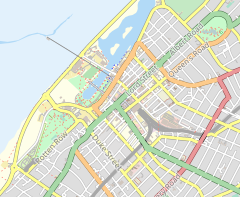
Great Crosby is an area of the town of Crosby, in the Metropolitan Borough of Sefton, Merseyside, England and is historically, part of Lancashire.

Wilmslow Road is a major road in Manchester, England, running from Parrs Wood northwards to Rusholme where it becomes the Oxford Road. The name of the road changes again to Oxford Street when it crosses the River Medlock before reaching Manchester city centre.

Over the centuries, there have been five theatres in Dublin called the Theatre Royal.

Buxton Opera House is in The Square, Buxton, Derbyshire, England. It is a 902-seat opera house that hosts the annual Buxton Festival and the International Gilbert and Sullivan Festival, among others, as well as pantomime at Christmas, musicals and other entertainments year-round. Hosting live performances until 1927, the theatre then was used mostly as a cinema until 1976. In 1979, it was refurbished and reopened as a venue for live performance.

Francis Matcham was an English architect who specialised in the design of theatres and music halls. He worked extensively in London, predominantly under Moss Empires for whom he designed the Hippodrome in 1900, Hackney Empire (1901), Coliseum (1903) and Palladium (1910). His last major commission before retirement was the Victoria Palace Theatre (1911) for the variety magnate Alfred Butt. During his 40-year career, Matcham was responsible for the design and construction of over 90 theatres and the redesign and refurbishment of a further 80 throughout the United Kingdom.

Southport Lord Street was a railway station located on Lord Street, Southport, Merseyside, England. It was the terminus of the Southport & Cheshire Lines Extension Railway from Liverpool.

Banks is a large coastal village in Lancashire, England, south of the Ribble estuary four miles (6 km) north-east of Southport town centre. The village is administered by West Lancashire Borough and North Meols Parish Council. It is in the South Ribble parliamentary constituency. At the 2001 census the population of the North Meols civil parish was 3,792, rising to 4,146 by the 2011 census.
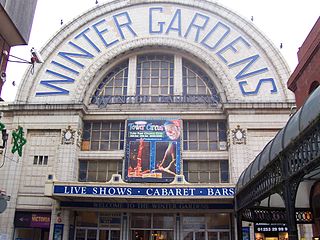
The Winter Gardens is a large entertainment complex in Blackpool, Lancashire, England, which includes a theatre, ballroom and conference facilities. Opened in 1878, it is a Grade II* listed building, operated by Blackpool Entertainment Company Limited on behalf of Blackpool Council, which purchased the property from Leisure Parcs Ltd as part of a £40 million deal in 2010.
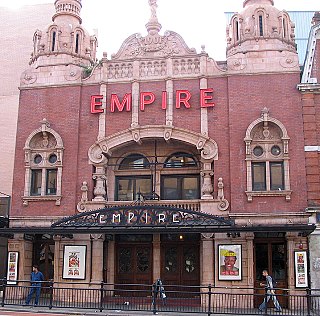
Hackney Empire is a theatre on Mare Street, in Hackney in the London Borough of Hackney. Originally designed by Frank Matcham it was built in 1901 as a music hall, and expanded in 2001. Described by The Guardian as "the most beautiful theatre in London" it is an Arts Council England National Portfolio Organisation.

The Liverpool Olympia is a venue in Liverpool, England, situated on West Derby Road next to The Grafton Ballroom.
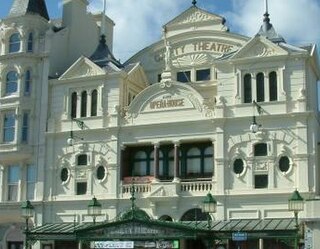
The Gaiety Theatre and Opera House is a theatre in Douglas, Isle of Man which together with the Villa Marina forms the VillaGaiety complex. The Gaiety is situated on Harris Promenade, overlooking the sea and adjacent to the Villa Gardens, Arcade and Butts.

The Winter Gardens is a Grade II* listed building in Morecambe, Lancashire, England. Designed by architects Mangnall and Littlewood, with Frank Matcham as a consulting architect, it was originally built as the Victoria Pavilion Theatre in 1897 and was an extension to the existing Winter Gardens complex, which has since been demolished. The theatre closed to the public in 1977 and was listed the same year. It is considered to be one of Morecambe's most significant features, and a campaign for its restoration has been ongoing since 1986.

Brighton Hippodrome is an entertainment venue in Brighton, England. It was built in 1897 and closed in 2007.

In 1898 William Morton's Theatre Royal showed a 'Veriscope' film, probably the first time any film was shown in a Hull theatre. The Prince's Hall was the first purpose-built cinema in Kingston upon Hull, and was opened in George Street by Morton in 1910. As Hull embraced the new age of public entertainment, attendances at traditional theatre declined. Luxurious cinemas, taking their inspiration from theatres and music halls, were built to accommodate audiences in almost every neighbourhood in the city. By 1914, there were 29 cinemas, theatres and halls showing films in the city. The London and Provincial Cinema Company owned the Hippodrome; the National Electric Picture Theatres owned the Theatre de Luxe, but Morton's was the largest and most influential cinema chain in Hull.
Aberdeen has been the host of several theatres and concert halls through history. Some of them have been converted or destroyed over the years.

The New Theatre Royal is a Victorian Grade II* listed theatre in the heart of Portsmouth, England, with a capacity of 648. The theatre building was constructed in 1854 as Landport Hall. It was converted to a theatre two years later. It was rebuilt in 1884 by Charles J. Phipps and again in 1900 by Frank Matcham.
The Theatre Royal, Hanley was a theatre in Stoke-on-Trent, England with a long history.
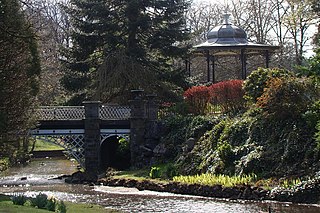
Buxton Pavilion Gardens is a Victorian landscaped public park in the spa town of Buxton in Derbyshire. The River Wye flows through the gardens, which are a Grade II* listed public park of Special Historic Interest.

The Pavilion Arts Centre was opened in 1889 as the new Entertainment Stage theatre on St John's Road in Buxton, Derbyshire, England. It is part of the Pavilion Gardens complex of buildings in the town's central Conservation Area. It has a main 360-seat theatre, and since 2017 it has been the home of Buxton Cinema.
The Empire Theatre was a theatre in Longton in Stoke-on-Trent, England. It was later a cinema and a bingo hall; it was destroyed by fire in 1992.

